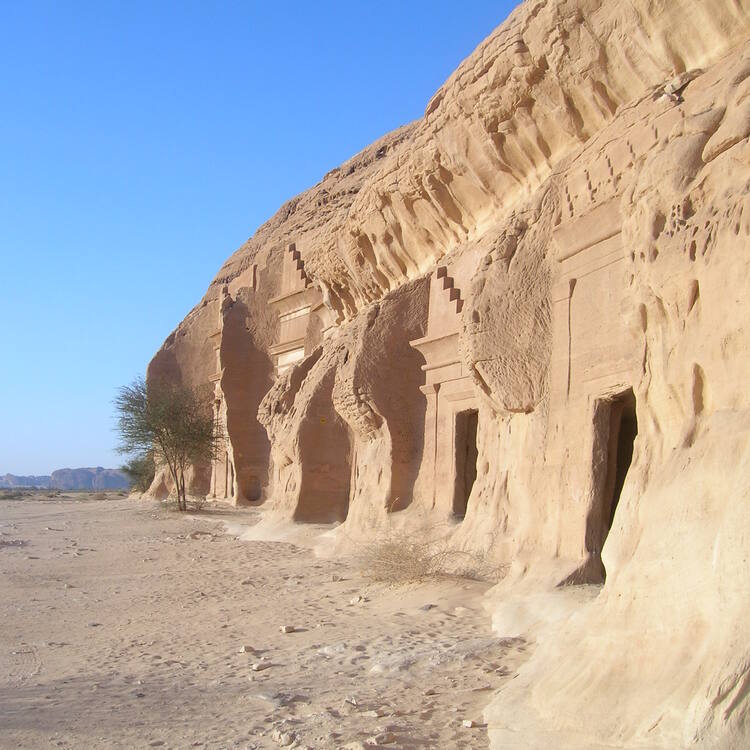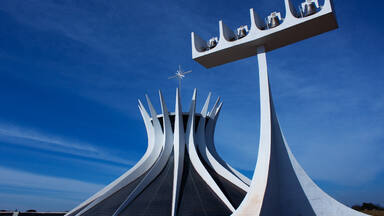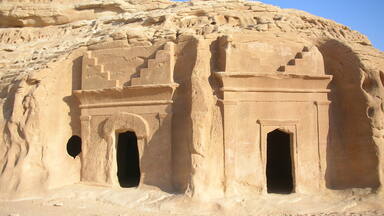Hegra Archaeological Site (al-Hijr / Madā ͐ in Ṣāliḥ)
Hegra Archaeological Site (al-Hijr / Madā ͐ in Ṣāliḥ)
The Hegra Archaeological Site (al-Hijr / Madā ͐ in Ṣāliḥ) is the first World Heritage property to be inscribed in Saudi Arabia. Formerly known as Hegra it is the largest conserved site of the civilization of the Nabataeans south of Petra in Jordan. It features well-preserved monumental tombs with decorated facades dating from the 1st century BC to the 1st century AD. The site also features some 50 inscriptions of the pre-Nabataean period and some cave drawings. Al-Hijr bears a unique testimony to Nabataean civilization. With its 111 monumental tombs, 94 of which are decorated, and water wells, the site is an outstanding example of the Nabataeans’ architectural accomplishment and hydraulic expertise.
Description is available under license CC-BY-SA IGO 3.0
Site archéologique de Hegra (al-Hijr / Madā ͐ in Ṣāliḥ)
Le Site archéologique de Hegra (al-Hijr / Madā ͐ in Ṣāliḥ), est le premier site de ce pays inscrit sur la Liste du patrimoine mondial. Anciennement appelé Hegra, il s’agit du plus important site conservé de la civilisation des Nabatéens au sud de Pétra (Jordanie), il comporte notamment des tombes monumentales aux façades décorées, datant principalement du 1er siècle avant J.C. au 1er siècle après J.C. Le site compte aussi une cinquantaine d’inscriptions de la période pré-nabatéenne et des dessins rupestres. Al-Hijr est un témoignage unique de la civilisation nabatéenne. Avec ses 111 tombes monumentales, dont 94 avec des façades décorées, et ses puits, le site est un exemple exceptionnel de la qualité de l’architecture des Nabatéens et de leur maîtrise des techniques hydrauliques.
Description is available under license CC-BY-SA IGO 3.0
الحجر (مدائن صالح)
يشكل موقع الحجر الأثري (مدائن صالح) في المملكة العربية السعودية، أول موقع لها يدرج في قائمة التراث العالمي. كان يسمى في الماضي الحجرة، وهو أكبر موقع مُصان لحضارة الأنباط جنوب البتراء بالأردن. ويحوي مقابر ضخمة مُصانة جيداً، تعود واجهاتها المزخرفة إلى القرن الأول قبل الميلاد وصولاً إلى القرن الأول الميلادي. الموقع قائم على مسافة 500 كلم من جنوب شرق البتراء، ويشمل حوالي 50 نقشاً من الحقبة السابقة للأنباط، وعدداً من رسوم الكهوف. يحمل موقع الحجر شهادة فريدة عن حضارة الأنباط. وتعتبَر مقابره الضخمة البالغ عددها 111 مقبرة (وقد زُين 94 منها بالزخارف)، وآباره المائية، مثلاً استثنائياً عن الإنجازات المعمارية للأنباط وخبراتهم الهيدرولوجية.
source: UNESCO/CPE
Description is available under license CC-BY-SA IGO 3.0
Археологический объект Аль-Хиджр
Это первый объект всемирного наследия в Саудовской Аравии. Ранее известный как Хегра, объект является крупнейшим сохранившимся памятником набатейской цивилизации, расположенным к югу от города Петра в Иордании. Здесь хорошо сохранились монументальные надгробные памятники с богато украшенными фасадами, относящиеся к периоду с I века до н.э. по I век н.э. Кроме того, на территории объекта сохранились около 50 надписей эпохи, предшествовавшей набатейской, а также несколько пещерных рисунков. Аль-Хиджр – уникальное свидетельство набатейской цивилизации. 111 сохранившихся здесь монументальных надгробий, 94 из которых богато украшены, и система колодцев являются выдающимися примерами набатейской архитектуры и накопленного опыта гидростроительства.
source: UNESCO/CPE
Description is available under license CC-BY-SA IGO 3.0
El sitio arqueológico de Al Hijr – Madain Salih
Es el primer sitio del Patrimonio Mundial inscrito en este país. Conocido en la antigüedad con el nombre de Hegra en la Antigüedad, es el sitio de la civilización nabatea mejor conservado al sur de Petra (Jordania). Comprende una serie de tumbas monumentales con fachadas ornamentadas, que se hallan en buen estado de conservación y datan de los siglos I a.C. y I d.C. Posee además medio centenar de inscripciones del periodo prenabateo y algunas pinturas rupestres. Al Hijr constituye un testimonio excepcional de la civilización nabatea. Sus pozos y sus 111 sepulturas monumentales, entre las que figuran 94 ornamentadas, son una muestra excepcional de las realizaciones arquitectónicas de los nabateos y de su dominio de las técnicas hidráulicas.
source: UNESCO/CPE
Description is available under license CC-BY-SA IGO 3.0
アル-ヒジュル古代遺跡(マダイン・サーレハ)
アル-ヒジュルの古代遺跡は、ヨルダンのペトラ以南では、現存するナバテア文明最大の遺跡。紀元前1~後1世紀初めにかけて繁栄し、かつてこの地にいた預言者サーレハにちなんで「サーレハの町(マダイン・サーレハ)」と呼ばれる。ここには四つの大きな墓地があり、装飾が施された94もの墓石群のほか、神殿、用水路や貯水槽などの遺跡が良好な状態で保存されている。いずれもナバテア人の建築技術と水利技術の高さを顕著に示すものとして、世界遺産に登録された。さらに一帯では、ナバテア文明以前の碑文や岩絵も約50発見されており、これらは紀元前3~前2世紀頃にこの地に住んでいたリヤーン人のものであると考えられている。source: NFUAJ
Archeologisch gebied Al-Hijr (Madâin Sâlih)
Het archeologisch gebied Al-Hijr (Madâin Sâlih) heette voorheen Hegra en is als eerste streek van Saoedi-Arabië toegevoegd aan de Werelderfgoedlijst. De plek is het grootst bewaard gebleven gebied van de beschaving van de Nabateeërs ten zuiden van Petra in Jordanië. De omgeving wordt gekenmerkt door 111 goed onderhouden graftombes – waarvan 94 met gedecoreerde voorgevels – daterend uit de 1e eeuw voor tot de 1e eeuw na Christus. Er zijn ook zo'n 50 inscripties uit de pre-Nabateeërs periode en enkele grottekeningen te vinden. Al-Hijer is met zijn monumentale graftombes en waterputten een voorbeeld van indrukwekkende architectuur en hydraulische expertise.
Source: unesco.nl
Outstanding Universal Value
The archaeological site of Al-Hijr is a major site of the Nabataean civilisation, in the south of its zone of influence. Its integrity is remarkable and it is well conserved. It includes a major ensemble of tombs and monuments, whose architecture and decorations are directly cut into the sandstone.
It bears witness to the encounter between a variety of decorative and architectural influences (Assyrian, Egyptian, Phoenician, Hellenistic), and the epigraphic presence of several ancient languages (Lihyanite, Thamudic, Nabataean, Greek, Latin).
It bears witness to the development of Nabataean agricultural techniques using a large number of artificial wells in rocky ground. The wells are still in use.
The ancient city of Hegra/Al-Hijr bears witness to the international caravan trade during late Antiquity.
Criterion (ii): The site of Al-Hijr is located at a meeting point between various civilisations of late Antiquity, on a trade route between the Arabian Peninsula, the Mediterranean world and Asia. It bears outstanding witness to important cultural exchanges in architecture, decoration, language use and the caravan trade. Although the Nabataean city was abandoned during the pre-Islamic period, the route continued to play its international role for caravans and then for the pilgrimage to Mecca, up to its modernisation by the construction of the railway at the start of the 20th century.
Criterion (iii): The site of Al-Hijr bears unique testimony to the Nabataean civilisation, between the 2nd and 3rd centuries BC and the pre-Islamic period, and particularly in the 1st century AD. It is an outstanding illustration of the architectural style specific to the Nabataeans, consisting of monuments directly cut into the rock, and with facades bearing a large number of decorative motifs. The site includes a set of wells, most of which were sunk into the rock, demonstrating the Nabataeans' mastery of hydraulic techniques for agricultural purposes.
The testimony borne by Al-Hijr to the Nabataean civilisation is of outstanding integrity and authenticity, because of its early abandonment and the benefit over a very long period of highly favourable climatic conditions.
The State Party has begun to set up an extremely comprehensive Local Management Unit, and this process is now under way. The announced management plan should enable satisfactory protection of the property. With this in mind, the plan should organise systematic monitoring of the conservation of the site, and prepare a project for the presentation of the Outstanding Universal Value of the property for the benefit both of visitors and of the population of the region.




